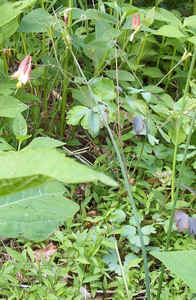 |
Common Name: Wild Columbine, Rock Bells
Scientific Name: Aquilegia canadensis
Family: Ranunculaceae
White Oak Mountain
Polk County, North Carolina
May 8, 2002
 |
The nodding flowers, borne on slender stems up to 3 feet tall, are an inch or more long counting the deep spur at the base of each petal. The leaves are divided into 3 rounded segments that may be divided again into 3 segments. A native perennial of the eastern U.S. that is found occasionally in rich, rocky woods at scattered localities throughout the state, but more frequently in the mountains. March - May [Justice, William S. and Bell, C. Ritchie, Wild Flowers of North Carolina. University of North Carolina Press, Chapel Hill, 1968]
Columbines are wildflowers of cliffs and rocky slopes where from April to September they display beautiful scarlet and yellow blossoms. The nodding flowers have 5 petal-like sepals and 5 tubular petals that project backward between the sepals into long spurs. The generic name of this plant (aquila, "eagle") is said to refer to a fancied resemblance between the talons of the eagle and the spurs of the flower. The stem, 1 - 2 feet high, bears rather small leaves, darker above than below. The lower and basal leaves are divide 2 or 3 times, into lobed and toothed leaflets. Columbines grow from the lowest altitudes to over 5,000 feet. [Stupka, Arthur, Wildflowers in Color. HarperPerennial, A Division of HarperCollins Publishers, New York, 1965]
If anyone presents you with a bouquet of columbine, you should think twice before saying thanks. The wildflower is a symbol of unfaithfulness and deceit, and receiving it is considered an insult. Aquilegia derives from Latin for "eagle", as the long spurs resemble an eagle's talons. The common name columbine is also from the Latin, columbinus, meaning "dovelike", although the flower looks nothing like a dove to us. If you look closely at the flowers, you may see tiny holes in the spurs. These were made by bees who were unable to reach the nectar through the long tube, so they punched a hole in the spur to give them access. Hummingbirds, with their longer mouth parts, are better adapted to retrieve the nectar, pollinating the plant in the process. April - July [Adams, Kevin and Casstevens, Marty, Wildflowers of the Southern Appalachians: How to Photograph and Identify Them. John F. Blair, Publisher, Winston-Salem, 1996]
Sometimes columbine is called rock bells for its habitat. It was once suggested this be our national wildflower because of its resemblance to eagle talons. Aquilegia is Latin for eagle. April - June [White, Peter, Wildflowers of the Smokies. Great Smoky Mountains Natural History Association, Gatlinburg, 1996]
The name "columbine" is from the Latin word columba, meaning "dove." Supposedly, the shape and proportions of the leaflets resemble the tail of a dove. Also known as red bells, this plant, with its persistent fragrance, was widely used by Indian tribes as a perfume. The fragrance was obtained by crushing and chewing the lustrous, black seeds into a paste which was then spread among clothing, where the sweet odor persisted for a long time. April - May [Alderman, J. Anthony, Wildflowers of the Blue Ridge Parkway. The University of North Carolina Press, Chapel Hill, 1997]
January February March April May June July August September October November December
Alphabetical Listings -- A B C D, E F G H I, J, K L M N, O P Q, R S T U, V W X, Y, Z
Family Listings -- A B C D, E F G H I, J, K L M N, O P Q, R S T U, V W X, Y, Z
Genus Listings -- A B C D, E F G H I, J, K L M N, O P Q, R S T U, V W X, Y, Z